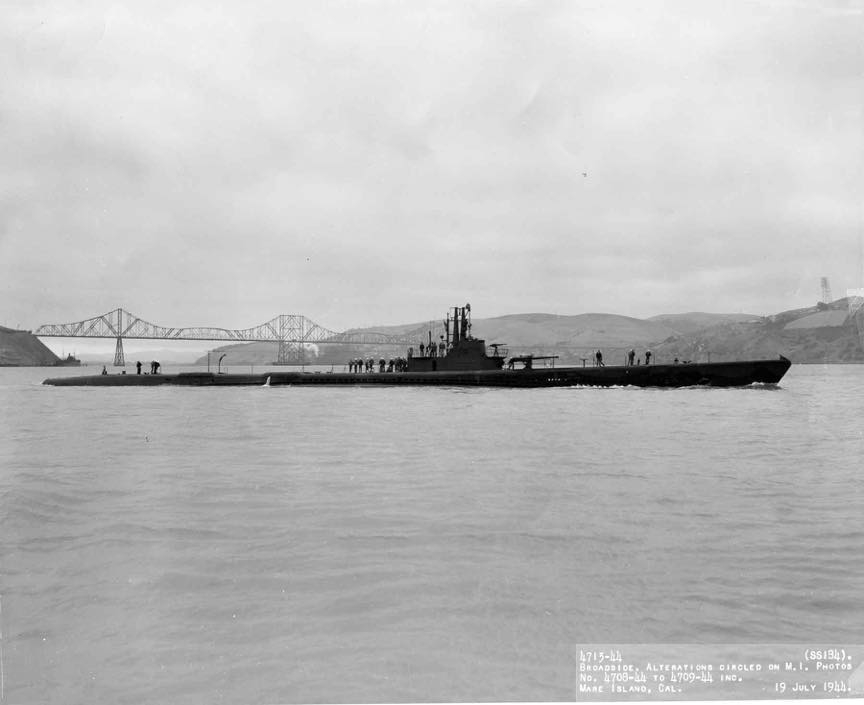Skipjack SS-184
 Skipjack
Skipjack
(SS-184: dp. 1,449 (surf.), 2,198 (subm.), 1. 308'; b. 26'1"; dr. 14'2"; s. 21 k. (surf.), 9 k. (subm.); cpl. 55; a. 1 3", 8 21" tt.; cl. Gato)
Skipjack (SS-184) was laid down by the Electric Boat Co., Groton, Conn., on 22 July 1936, launched on 23 October 1937; sponsored by Miss Frances Cuthbert Van Keuren, and commissioned on 30 June 1938, Lt. Herman Sall in command.
Following shakedown in the Atlantic and Caribbean and post-shakedown repairs at New London, Conn., Skipjack was assigned to Submarine Squadron (SubRon) 6 and departed for fleet maneuvers in the Caribbean and South Atlantic. Following her return to New London on 10 April 1939, she sailed with Snapper (SS-185), and Salmon (SS-182), for the Pacific, transited the Panama Canal on 25 May, and arrived at San Diego on 2 June. During July, she cruised to Pearl Harbor as part of SubRon 2; returned to San Diego on 16 August; and remained on the west coast engaged in fleet tactics and training operations until 1 April 1940, when she again got underway for the Hawaiian area for training exercises there. Following her return to San Diego, Skipjack underwent overhaul at the Mare Island Navy Yard, Vallejo, Calif., and then proceeded back to Pearl Harbor, operating in that area until again undergoing overhaul at Mare Island in July and August 1941. Skipjack arrived back at Pearl Harbor on 16 August and commenced patrols in areas off Midway, Wake, and the Gilbert and Marshall Islands. When the Japanese attacked Pearl Harbor on 7 December, Skipjack was in the Philippines undergoing repairs at th~e Cavite Navy Yard.
On 9 December, Skipjack departed Manila on her first war patrol, with all unfinished repair work completed by her crew en route to the patrol area off the east coast of Samar. The submarine conducted two torpedo attacks during this patrol. On Christmas Day, she fired three torpedoes without success at an enemy aircraft carrier and a destroyer. On 3 January 1942, three torpedoes were fired at an enemy submarine, resulting in two explosions, but a sinking could not be confirmed. She refueled at Balikpapan, Borneo, on 4 January and arrived at Port Darwin, Australia, for refit on 14 January.
Skipjack's second war patrol, conducted in the Celebes Sea, was uneventful with the exception of an unsuccessful attack on a Japanese carrier. She returned to Fremantle, Western Australia, on 10 March.
On 14 April, Skipjack got underway for her third war patrol, conducted in the Celebes, Sulu, and South China seas. On 6 May, contact was made with a Japanese cargo ship, and the submarine moved in for the kill. Finding herself almost dead ahead, Skipjack fired a "down the throat" spread of three torpedoes that sank the Kanan Maru. Two days later, the submarine intercepted a three-ship convoy escorted by a destroyer and she fired two torpedoes that severely damaged the merchant ship, Taigu Maru. Then she let go with four more that quickly sank the cargo ship, Bujun Maru. On 17 May, Skipjack sank the passenger cargo ship, Tazan Maru, off Indochina before heading back to Fremantle.
Following participation in depth performance tests for the Mark l4 torpedo, Skipjack sailed for her fourth war patrol on 18 July, conducted along the northwest coast of Timor which she reconnoitered and photographed. She also severely damaged an enemy oiler. The submarine returned to Fremantle for refit on 4 September.
Skipjack's fifth war patrol was conducted off Timor Island Amboina, and Halmahera. On 14 October, while patrolling south of the Palau Islands, the submarine torpedoed and sank the 6,781-ton cargo ship, Shunko Maru. Following ~a depth charge attack by a Japanese destroyer, the submarine returned to Pearl Harbor on 26 November.
Skipjack's sixth, seventh, and eighth war patrols were unproductive. But, during her ninth conducted in the Caroline and Mariana islands areas, she sank two enemy vessels. On 26 January 1944, she commenced a night attack on a merchant ship, but, prior to firing, she shifted targets when an enemy destroyer began a run on the submarine. She quickly fired her forward torpedoes and was rewarded with solid hits what quickly sank Suzukaze. The submarine then fired her stern tubes at the merchant ship. One of the submarine's torpedo tube valves stuck open and her after torpedo room began to flood. The torpedomen were unable to close the emergency valves until she had taken on approximately 14 tons of water. A large upward angle developed almost immediately, forcing the submarine to surface. By the time control of the boat had been regained, the water in the torpedo room was only a few inches from the top of the water [Light door, but fortunately there were no casualties, and Skipjack resumed the attack. The submarine then torpedoed and sank the converted seaplane bender, Okitsu Maru. She returned to Pearl Harbor on 7 March.
Following repairs, Skipjack participated in performance tests on new torpedoes in cold water off the Pribilof Islands until 17 April and then headed for the Mare Island Navy Yard and overhaul.
After returning to Pearl Harbor, Skipjack got underway for her tenth and final war patrol, conducted in the Kuril Islands area. During this patrol, she damaged an enemy auxiliary and attacked a Japanese destroyer without success. On 11 December, she returned to Midway and then continued on to Ulithi. She then sailed to Pearl Harbor for refit: and got underway on 1 June 1945 for New London, Conn., and duty training submarine school students. Skipjack was later sunk as a target vessel in the second atomic bomb test at Bikini Atoll in July 1946 and was later raised and towed to Mare Island. On 11 August 1948, she was again sunk as a target off the coast of California by aircraft rockets. Her name was struck from the Navy list on 13 September 1948.
Skipjack (SS-184) received seven battle stars for World War II service.
